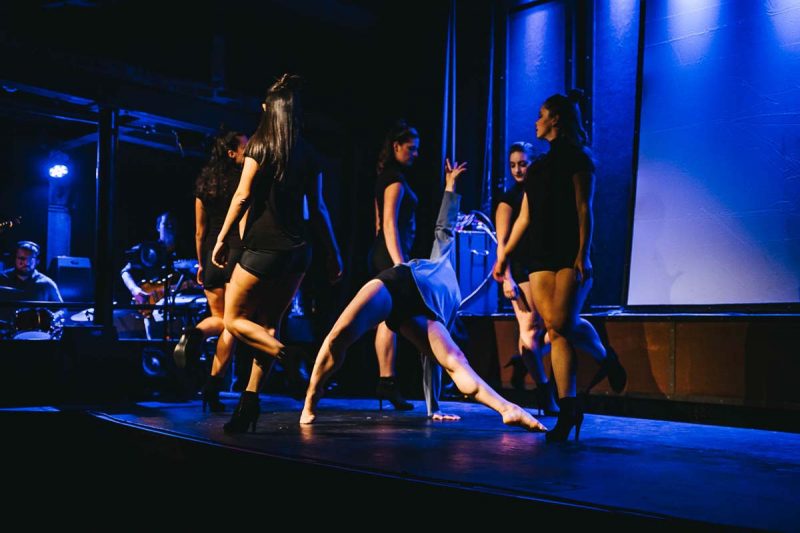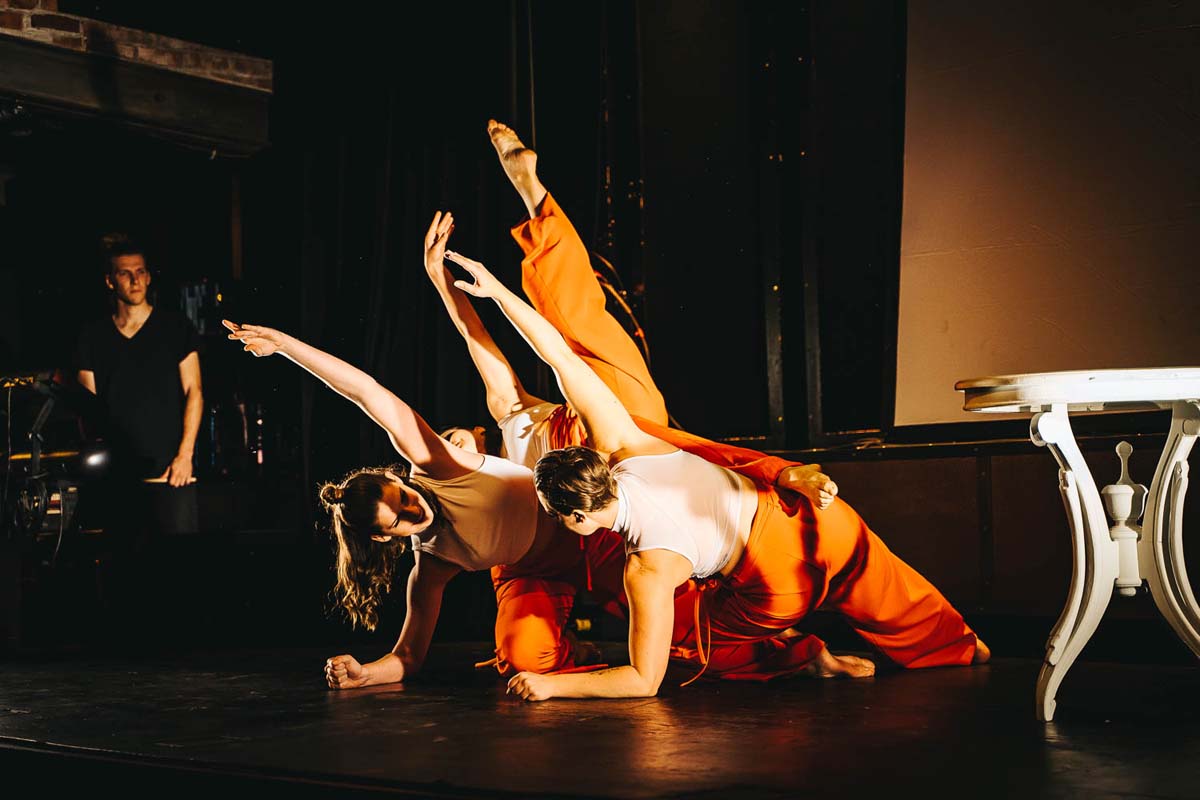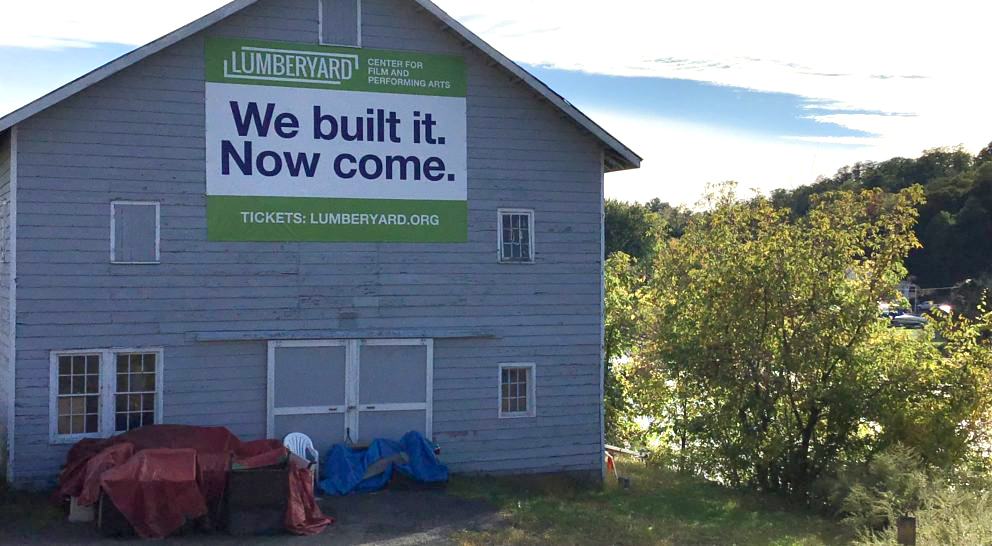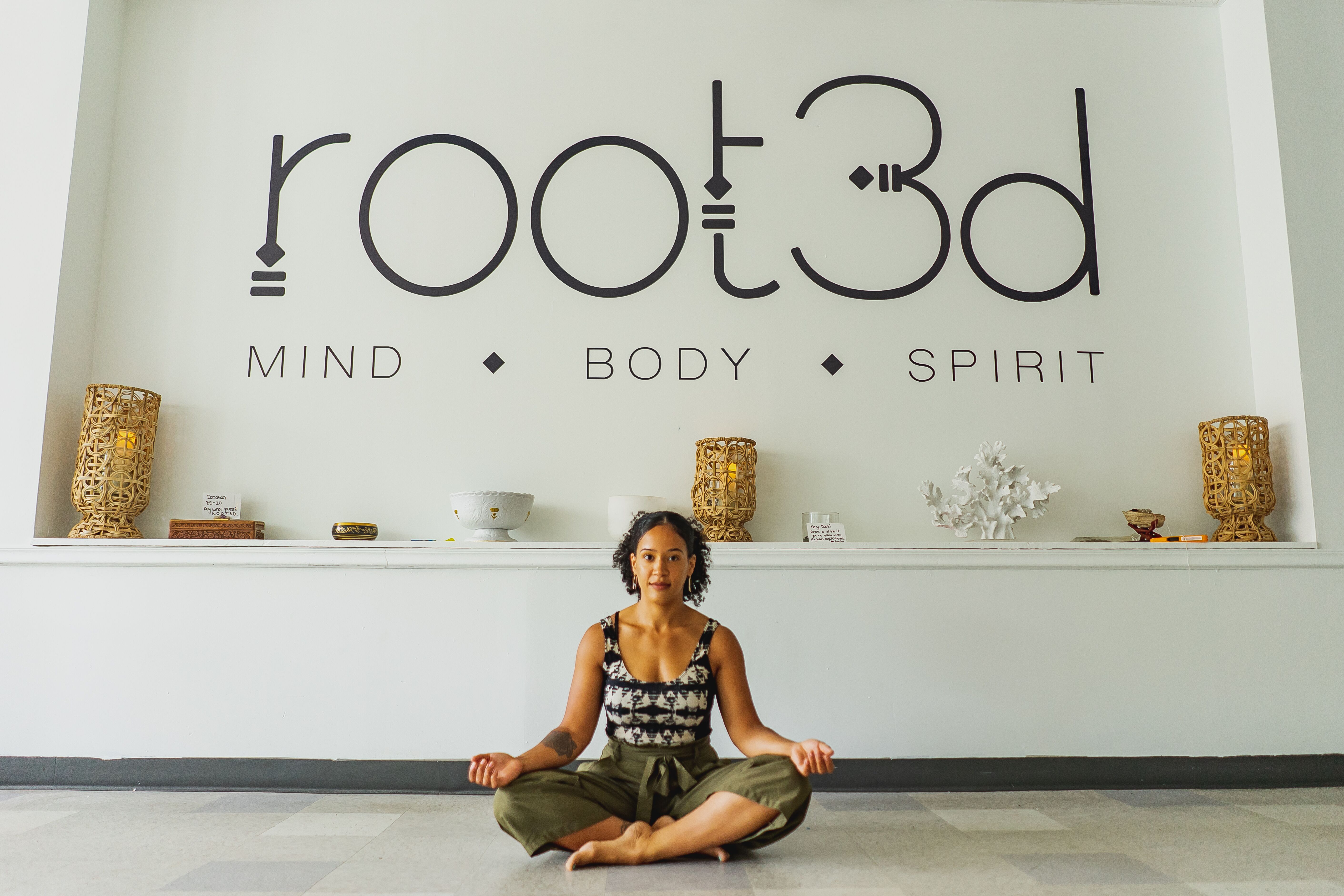Above: Nadine Medina photographed by Kiki Vassilakis. Story photos by Richard Lovrich
Sometimes choreography comes to Nadine Medina when she is on the verge of a deep sleep. It’s 2 a.m. and she shoots out of bed, presses record on her iPhone and bangs out a 16-count dance sequence. Other times, she’s leaning down to pour food into her dog’s bowl and the way her body bends inspires her to work through a new set of 16 counts. Her ideas live in short spurts of video or audio recordings, recollections of imaginary dancers who move to the tune of a song that is stuck in her head.
“Even just if I’m still in bed I’ll talk through what I saw, ‘OK, I just saw these six dancers doing this weird lifting thing,’” Medina says. “I used to force it and be like, ‘I have to choreograph these 32 or 64 counts and this is the time that I have right now to do it.’ That made sense, at the time, for where I was at.”
With 25 years of choreography experience under her belt and a demanding dance schedule as both the owner and artistic director of Troy Dance Factory and Retold Dance Company, Medina has had a lot of space to explore her craft and creative process.
“My trust in my instincts has strengthened. It’s a lot more polished and authentic than when I used to force myself,” she says. “That’s not to say that I still don’t force myself because schedules are a reality, but at least the work is stronger because it comes from a place of vision rather than a place of frustration.”
That grounding state of strength and patience has been an important lesson Medina has learned over the years.
“How you start your work, and the mood you’re in while you do your work, makes a huge difference in a creative endeavor,” she says. “If you’re starting from this place of ‘I don’t have any ideas,’ immediately–whether you think of it this way or not–it’s a negative place to put yourself in. You’re fighting an uphill battle.”
“Sometimes I say, ‘I wish I had a Nadine for me,’ because I say to my dancers all the time–and they’ve repeated back to me actually, “Look, if you don’t believe in yourself right now that’s OK. I’m telling you right now that I believe in you, and she does and he does and if you don’t that’s fine. Let us do that heavy lifting for you.’”
When she hits a creative wall, or finds herself cornered by that state of mind, Medina opts to distract herself in other creative genres than dance to get into a completely separate flow. Or, she’ll get lost in viral videos of avant-garde dance to remind herself that the rules of choreography are really more of a guideline.
“It’s like it gives you permission to unblock,” she says. “So what if you ask your dancers to walk for four counts to a new place? The 16 counts before and the 12 counts after are hella intense so why does everything have to be on the same level? It doesn’t. People stop listening if it’s monotone anyway.”
Dance offers so many possibilities of movement, it can be a dizzying beast to take on.
“I remember not the instance, but the feeling of putting my arms behind me,” Medina grins. “It’s the smallest thing like that. You put a limb in a physical space where it’s not used to being, in relation to the rest of your body, and all the sudden your mind is blown because it seems so common sense and obvious, but now there are 30 different moves at least that you can explore right off the bat.”
In every project, Medina starts with a song. It’s been the main source of mental pressure the artist says she has felt throughout her newest course at Troy Dance Factory.
“It’s one thing to do a piece to a famous artist. It’s another to know someone and really like someone and feel like, ‘I really hope I do you justice and I hope I don’t let you down,’” she says. “That’s one thing I said to James [Rock] and I don’t normally talk this way to myself anymore. I really have to tell myself to stop thinking that way because that’s when you get stuck in a rut. It’s nice that I’m as busy as I am with the studio and the dance company because I don’t have too much time to get lost in that thought process.”
The choreographer has been exploring the music of Capital Region artists, inspired to add yet another dance class to her 14-course workload, one that has proven to be one of her most challenging yet. In a 10-week choreography course that maxed out attendance within a week of its announcement, 22 dancers are learning highly technical, contemporary hip hop numbers set to “Parallel” by James Rock, “The Moon” by Dark Honey and “All Go Right” by The Sea The Sea.
In the “Parallel” number, for example, Medina has all 22 dancers working with chairs, blending into partner sequences, mirroring the movements until they finally turn away from each other and everything becomes the opposite of its original movement. It’s a testament to the feeling of Rock’s song, Medina says, in which the end of a relationship leaves both parties feeling as if they will go on forever living their lives in parallel.
In “The Moon,” the choreographer sees something even more massive and cinematic. “I want to use a part close to the end where your brain is exploding with images,” she says excitedly, walking herself through a series of parts to utilize the different styles and abilities of her dancers. One idea she describes includes a number of her dancers occupying a low “sea” of movement in support of the “canvas” of a series of lift sequences.
“I don’t know if that’s crazy,” she pauses and shrugs, “It’s crazy, but I’m gonna do it anyways.”
The class was also inspired by the ongoing Instagram trend featuring dance studios around the world choreographing to popular singles by chart toppers like Justin Bieber and Cardi B. In return for their viral videos, dancers have gotten the chance to star in major music videos. Bieber even devoted a side project for his 2015 album Purpose to the trend.
“They’re supporting each other in a sense,” Medina says. “For me, I just feel like it’s not the people in LA who need all the help. We have a lot of great musicians here so even though it’s a different scale and a different location, I thought it would be cool to bring that energy here. Between getting to know the bands, getting to know their music and seeing the trends that are happening in LA, I thought, ‘Well, we can do that too.’”
Despite her insistence in the class announcement that it wouldn’t exactly be a beginner level course, she lends credit for the quick sign-up to the popularity of the videos as well as their tendency to propel individual dancers and dance studios into the spotlight.
“Most people these days just want choreography which, again, thank you Los Angeles for making everybody believe they don’t have to do any foundation or skill training,” she laughs. “I actually said that the class was going to be intermediate, it would be any style I wanted, including heels.”
The response to her idea, she adds, was a pleasant surprise. “Part of me hoped people would want to dance to local musicians but then another part of me thought, ‘They want to dance to Cardi B.’ Since then I’ve had so many dancers coming back to the studio like, “I’ve had the James Rock album on repeat for a week, I know all the words if you want me to scribe them for you!”
By the time their course ended, the week before Thanksgiving, the dancers have had to memorize choreography they finalized up to eight weeks before. They’ll be performing the three pieces as separate music videos filmed by Chromoscope Pictures.
“This course holds a lot of weight,” Medina says, “It’s something that I take seriously and that I know they take seriously as well. You are representing an artist here. We have a little more responsibility than your average short session piece. I want this to be something that the artist can really benefit from.”
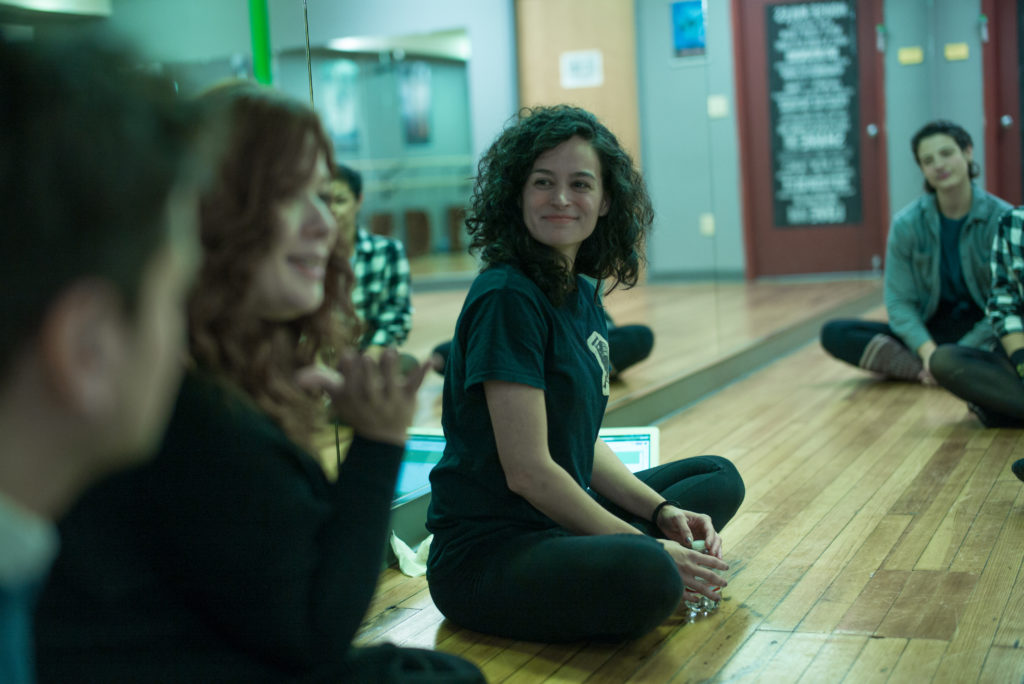
In the mirrored Troy Dance Factory, Medina sits with her students, listening intently to Chuck and Mira Costa of The Sea The Sea. The artists have dropped by to delve into their song “All Go Right” with the dancers who will bring it to life.
They explain the nature of the song, which translates in metaphors like an anchor floating like a feather or a wildfire resuscitating an ecosystem. The action of undergoing intense pressure, destruction, trauma, and heartbreak to come out on the other side stronger and brighter.
As the vocals swell and expand through the silence of the room, the dancers close their eyes and sway. Arching and caving their backs, pointing and curling their toes, it is as if their bodies have been ingrained into the song, like it’s the only way they know how to breathe.
“We do this for improv,” dancer Amanda Blount tells The Sea The Sea excitedly. “It lets you be outside of yourself.”
Medina has chosen to choreograph the bridge of the song, a transition moment that is less lyrically driven than the rest of the song which allows her to tell a whole new story.
“It’s more just feeling,” she says. The break represents the pivotal moment of letting go, when there is nothing left to say. When she explained her idea to the band, they dove right in.
“It’s interesting because the bridge was actually the last part of the song that we wrote,” Mira says. “Even musically, that vocal line wasn’t in there. Any lyric we came up with got in the way, emotionally. We wanted to use the voices like strings, to show something but also not.”
“When things are crazy and chaotic, knowing that there is the potential that it will all go right, that maybe I’ll come out of it, there’s a point in which you can’t say anything more to articulate that,” Chuck adds. “That was the moment in the song that it all kind of crystallized.”
The story Medina has chosen to tell is deeply personal, one of finding strength from trauma, of pulling that strength from the loving and open community she has found through Troy Dance Factory.
For this routine, Medina has opted to drape the dancers like a dome. As they the spin away, the viewer is left with one lone performer who is pulling another on top of her, asking for protection. It’s the same love and protection Medina received from her dance family after being brutally beaten by several strangers over a month ago.
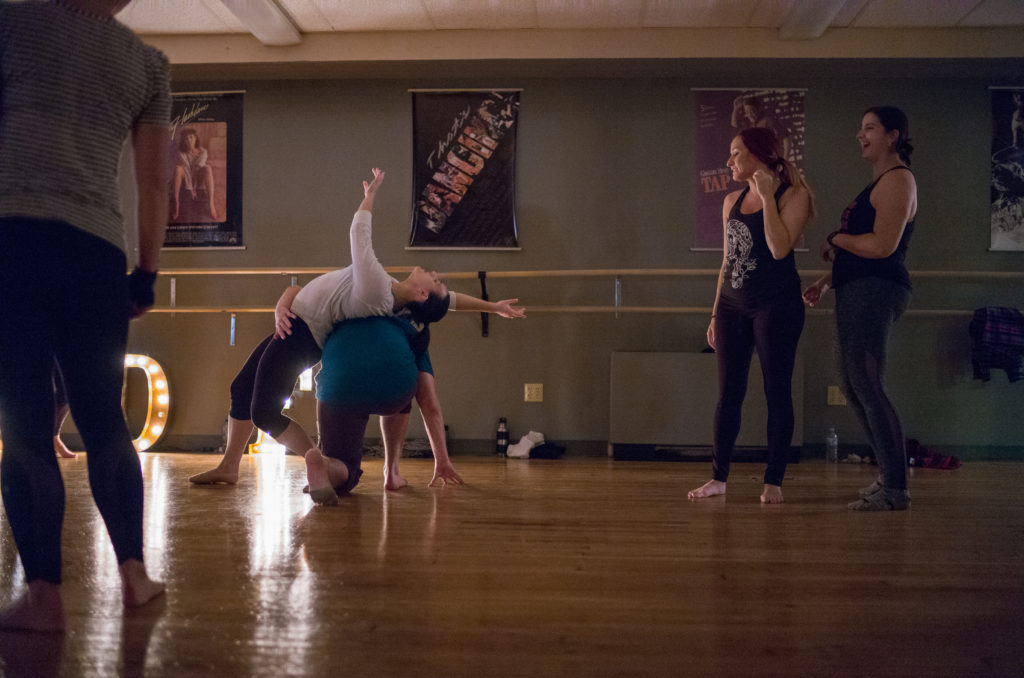
“When this person was able to go through the process of having to go through what they went through by having these people on them, there is this growth,” she explains. “The most important art comes from truth.”
Recovering from that trauma, she says, was a changing experience. It has pushed the choreographer to hold her loved ones closer, appreciating things more. Despite the fact that her attack came to no resolution or justice, her difficult journey to find closure has been alleviated by the support of those who helped pick her up along the way.
“That experience was huge, huge, huge for me. I’m still really angry about it. I can’t not pull that into my art,” Medina tells the class. “There was a time where I thought, ‘I’m gonna be really fucked up for a long time.’ But it turns out, in that mess, a lot of good things came out of it because everyone surrounded me with love and support. That was my pressure, my chaos…a lot of you were that community for me.”
With supportive nods, the dancers begin to stretch and mentally prepare for the story they’re about to take on. After a moment, Bloundt bounds over to the Costas with tears in her eyes to express her thanks for the song they have made, which had ignited her own emotionally significant connection.
After taking it all in, the musicians share how honored they are that Medina has chosen to tell her story through their sounds and how interesting to see the many ways their art can be interpreted.
Medina’s class has allowed interdisciplinary relationships to blossom, creating a new fanbase for the musicians and a deeper understanding–and appreciation–of storytelling through movement, especially when words alone can’t do it justice. It’s a reminder that your new favorite art could be by someone right next door and a piece of art you make can be another’s saving grace.


